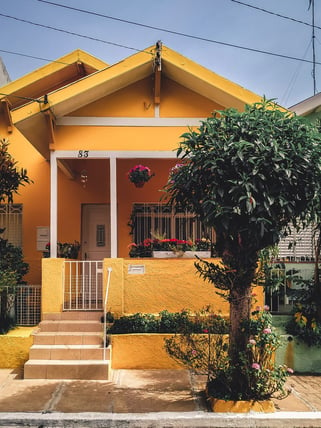Exterior doors come in many different styles and materials whether they’re used as front doors, side doors, or rear doors. Different types also offer different levels of durability and maintenance needs. In climates that see a lot of snow, rain, or extreme weather, some door types may be better choices than others. If you’re building or investing in areas with any kind of extreme weather, be it heat, cold, or anything in between, you may even consider a storm or screen door. Below is a breakdown of some of the most common exterior door types used today.
Wood
Solid wood exterior doors are a beautiful option but can also be a costly one. Entry doors made of solid wood tend to be strong and durable but can warp and expand or contract over time. They do require regular maintenance such as repainting or restaining. Most wooden exterior doors are made using a frame and panel system, with solid wooden panels making up the vertical length of the door, though solid flush doors are also available. If an exterior wood door is being used in an area with a lot of precipitation, an awning, overhang, or porch is a good feature to have for added protection from the elements. Generally speaking, unless you are building high-end or luxury homes, some of the below options may be better door options.
Fiberglass
Fiberglass doors are weatherproof and foam insulated making them a durable and energy efficient choice. Many are also made with a wood grain finish which can be painted. They are far less likely to warp than wood doors and are fairly impervious to dents. Fiberglass doors are also the lowest maintenance type of entry door, needing only occasional washing with soap and water. This makes them appealing to potential buyers and an easy sell, for you, the investor. From a cost standpoint, prices vary, with higher end models being comparable to solid wood doors. According to fixr.com, “A quality fiberglass door can cost anywhere from $800 to $1,000, while a higher-quality fiberglass door can run from $1,500 to $2,500.”
Steel
Steel doors are strong, durable, weatherproof, and sometimes include an insulating layer. They are a popular option due to the fact that they come in many different colors and styles, and can even be made to feature a wood grain. Most steel doors are made using 20 or 24 gauge steel and generally have a long life span. They tend to be the least expensive exterior door option but they can dent easily so they may not be the best choice for high traffic areas such as multi-unit residential buildings or common areas in buildings. Steel doors can potentially rust if the galvanized exterior layer is scratched through.
Storm and Screen Doors
Storm doors and screen doors are installed outside of the main exterior door for added protection, security, and ventilation but the terms are not interchangeable. Screen doors tend to be lighter than storm doors and consist mostly of a framed screen. They are used mainly for letting light and air in in warmer months while keeping insects out. Most screen doors are framed using aluminum, vinyl, or wood.
Storm doors, on the other hand, offer more protection from the elements as their name suggests. Storm doors are also installed in front of the main entry door and are usually made from aluminum, steel, or vinyl and can range anywhere from $100 to over $1000. Aluminum and steel clad doors tend to be the strongest options and the best for adding an extra layer of protection form high winds, snow or other heavy precipitation.
Many storm doors in today’s market are very attractive and do not hinder the overall style of the home. In fact, some storm doors consist of a large glass panel framed with steel or aluminum. These are called ‘full view’ storm doors. Not only are they a sleek option, they also let in the most light if the main front door is left open. Good quality storm doors can add value to a home and give you a better return on your investment, especially in cold regions or areas with a lot of snow.

Recent Posts
- Spec Home Loans: Complete Guide to Construction Financing for Builders
- Spec Construction Loans: A Spec Line of Credit Is Worth the Paperwork
- Spec Homes and Pre-Sale Homes: Relative Benefits for a Spec Builder
- Spec Construction Success: Insights for the Investor Builder
- How Is a Spec House Different From Other Kinds of House Construction?
